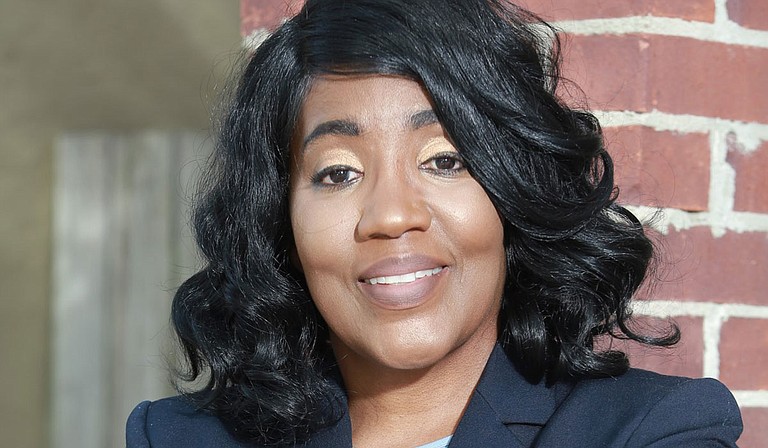Joyce Sartin, founder and director of Daughters of Baca, survived years of domestic abuse before finding freedom from the isolation and control. Now, she works to provide resources to women struggling with the same issues. Photo courtesy Joyce Sartin
Wednesday, June 10, 2020
For Joyce Sartin, it started with a shove. An argument in the car ended with her then-boyfriend pushing her roughly against a door. It was the first warning sign of many, but Sartin put it out of her mind. "When you're 20 years old, you don't know that maybe a push can turn into full-blown domestic violence," she told the Jackson Free Press.
The violence escalated the moment they left the orbit of her family, moving to Fort Bragg, N.C. Her abuser took full advantage of the separation the move provided. "Isolation is key," Sartin says, adding that it is one of the strongest control methods that lies at the heart of partner violence.
Her ex decided what Sartin was allowed to do. She couldn't drive—he would drop her off at work. When he saw her laughing with a male coworker, he forced her to quit. He would interrogate her friends about their conversations. Sartin found a journal he kept about what she said to him. The paranoia stopped her from reaching out to others.
Sartin needed a support network to break out of the abuse cycle, but it was back in Mississippi. "Where you gonna go?" he'd ask her. "You can't go home to your family with these kids."
It was nonsense, gaslighting, a deception piled up on all the other cruelties he inflicted in their years of living together.
But a lie, repeated enough, can come to resemble the truth.
"Even though I knew it was wrong, they'll say it so many times that (you start) to believe what they're saying," she said.
Sartin was utterly lost, afraid to call the police and without confidants to share her fears with. "Well, where can I go?" she asked herself at the time. "Nobody wants to try to help me, and I've got these kids. Nobody wants to get involved."
Her abuse took place in the early 1990s, coming to a head when her ex ordered her out of their shared apartment with her son Marcus, locking them out. Sartin can't remember what angered him that day. "You don't know what you're going to say that's going to set him off," she said. She contacted his superior officer and begged him for assistance.
Soon Sartin was on a bus with her son, headed back to Mississippi. There, in her hometown of Brookhaven, she encountered law enforcement from her own community who knew her, and helped protect her, even when her abuser followed her across the country.
But Sartin's experience is an outlier, and few understand this better than Byram Police Chief Luke Thompson.
'We've Just Arrested Everybody'
Chief Thompson realized at an April 2017 conference on interpersonal violence in Seattle that his force was handling domestic-violence disputes with the same heavy hand as they did other crimes. The conference introduced him to the "lethality assessment," a tool academic nurse Dr. Jacquelyn Campbell developed to direct responders to assess the imminent danger to victims at the scene of domestic disputes.
Thompson acknowledges that the typical method of responding to a domestic call fails both the victims and the community at large. Before the new approach, the difficulty of communicating with victims and aggressors in a domestic dispute—as well as the dangers of entering a home in a volatile situation—frequently led officers to treat everyone involved as a potential threat, whether aggressor or victim.
"Domestic violence is the only time in state law that I, as a police officer, am absolutely mandated to make an arrest if I determine a domestic-violence incident has occurred, and if I can determine a principal aggressor," Thompson said.
But that mandate is easily misunderstood, he warns. "So unfortunately what happens is officers go on the scene ... and this is the statement that gets made: If I come back out here, I'm going to take everybody to jail."
"And that's the way we've done business for a really long time. And unfortunately in the Byram Police Department, we did business that way for a few years."
Reviewing the numbers from Byram's 2017 domestic-violence responses, Thompson called in a patrolman to discuss the numbers. "What does this number say to you?" the chief asked. "In 2017, we took 26 reports, and arrested 40 people."
"It means we've just arrested everybody," the patrolman responded.
'A Criminal Offender Approach'
Back in Mississippi, Sartin had the support of her family again. But freedom from her abuser was short-lived. "He was dishonorably discharged from the military. I'm at my mom's house one day, and I turn around ... and he's at the door," she said.
They never lived together again. But the abuse continued to escalate. Sartin's ex-husband became a truck driver, sweeping in and out of town without her awareness.
"We never knew when he was in town," Sartin said. "So he would do things like come to the house and leave the door halfway open, to make us think someone had broken in. I'd have to call the sheriff for a walk-through to make sure it was OK for me and the kids to go in."
As the abuse Sartin suffered grew, she eventually involved the police. Brookhaven is a small city, and she considers herself unusually fortunate that she knew the police, and that they understood her situation. Both times Sartin called law enforcement, they arrested her abuser.
Chief Thompson has statistics to show that not all victims are so fortunate. Of domestic-violence homicides nationwide, "a third of the victims have had some sort of contact with law enforcement in the year prior to their killing, yet only 4% of victims get some sort of help," Thompson said.
That means that 29% of domestic-violence homicide victims had an interaction with law enforcement within 12 months of their deaths without being connected to the services or resources that might have saved their lives, a missed opportunity that Thompson considers an unacceptable failing.
The criminal-offender approach, as Thompson describes it, is indicative of a larger approach to solving social ills through policing. "We have not made that connection between victim services and criminal services," he explains. But the police baton is no tool for assisting a victim of domestic abuse. Thompson warns that the hard approach makes victims less likely to seek and receive help at all.
Wendy Mahoney, executive director for the Mississippi Coalition Against Domestic Violence, told the Jackson Free Press that law enforcement cannot assist with domestic violence without understanding it first. "There has not been a clear understanding of the dynamics of domestic violence, what it is and what it is not—the cycle of it," she said.
Technological Reform
Over the last several years, Thompson has attempted a drastic reform of how his officers respond to domestic violence. A technological change is that Byram has advanced from a "universal crime reporting," or UCR, system to a "national incident-based reporting system," called NIBRS.
The original UCR system includes the most significant crime reported in an incident, nesting lesser crimes within it. For example, Thompson explained, the system would log a burglary turned into a murder as a murder alone. The NIBRS system creates a much more complex map of crimes, including individual summaries of all the crimes committed, and most critically, maps out the relationships between all the individuals in all the crimes.
The NIBRS model expands the ability to highlight, search and understand a domestic-violence incident on an infinitely wider scale than before. Starting in 2021, a NIBRS system will be mandatory for all law-enforcement agencies in the country. Mississippi's attorney general's office put out a request for proposal for a new uniform domestic-violence reporting system in 2019 that must be fully NIBRS compliant.
That project was put on hold with the election of Lynn Fitch as attorney general last November, but Jeannie Williford at the Mississippi Department of Information Technology Services told the Jackson Free Press that a contract award is expected in a matter of weeks.
Trauma-Informed Options
Even more important to Thompson's reforms is the trauma-informed approach his officers now take with domestic calls. In addition to frequently arresting victims of domestic violence, Byram's police department previously treated domestic disturbances as "annoyances," hostile encounters often fruitless to pursue and dangerous to the officers involved.
Now, equipped with the lethality assessment, which asks pointed questions about the degree of abusive behavior the aggressor has previously displayed, officers know how to detect imminent danger to a spouse or partner's life.
When these factors are detected, the victim is immediately connected to a domestic-violence shelter, and provided with transportation not in the back of a caged-in patrol car, but a supervisor's car without the trappings of incarceration.
"I don't want them to feel like they're being revictimized," Thompson said.
Thompson is passionate about the results of the new protocols. In the years since 2017 his department has seen its domestic-violence reports double, but its related arrests nearly cut in half.
In 2018 there were 48 reports and 24 arrests—in 2019 that number was 59 reports and 28 arrests, a totally different proportion than the 26 reports and 40 arrests in 2017. That means the Byram Police Department is now arresting at roughly one-fourth of the rate it had in previous years. Calls for service have dropped with the numbers. "We're not going to the same locations multiple times, dealing with the same offenders multiple times."
Thompson credits swift intervention and trauma-informed practices for the change. "Whereas before it was, if I come back, everybody goes to jail. Now we have a scientifically proven instrument to know ... that there is an imminent risk of serious bodily injury or death. So we know to take the next step ... We put the victim on the phone with a counselor right there on the spot," he said.
Sandy Middleton, executive director of the The Center for Violence Prevention, which partners with Byram for victim services, holds Thompson and his department up as a model for successful domestic-violence intervention. So does Mahoney—Thompson sits on MCADV's board of directors.
'What If We Quit This Bullsh*t?'
But Thompson's comparative success raises the question of why such distinct personal vision is necessary for a police department to avoid the revictimization of survivors of domestic violence. The Jackson Free Press asked Thompson if the practice of armed police filling the role of social services was worth questioning.
"I think so," Thomas said. "Go back and look at the last several years in our own state Legislature and where the budgets have been cut. We've cut mental-health spending tremendously. (We've cut) human services ... Add the corruption that's been in the Department of Human Services. I don't think we'll see the full effects of that for years."
"You look at social services, police services, what behaviors are criminalized, what systems are in place. I thought about this—what would it look like if we quit this bullsh*t? What if the war on drugs became a public-health problem instead of a criminal problem?"
Thompson argues that the responsibilities of his police force—and those of police in general, are determined at the legislative level. Both the boundaries of his job and the funding that provides alternative avenues for addressing issues like domestic violence are generated at the State Capitol.
Middleton agrees, suggesting that, rather than an issue of over-policing, the challenge is that "in the areas where victim services aren't available, I think that it is difficult for law enforcement to do their jobs, as well as meet the needs of the victim." Comprehensive victim services, Middleton says, are the only way to meet the gaps that are otherwise filled in by law enforcement.
Cross-training, Middleton says, is key. Sartin believes victim services and law enforcement best work hand in hand.
"If police officers could connect with a domestic violence advocate ... there may be some barriers that the advocate is trained to handle," Sartin says.
"It's not a model that we made up. This is not anything new. We hope that by getting more agencies to do it, they'd probably see similar results." Thompson said.
Email tips to [email protected].




Comments
Use the comment form below to begin a discussion about this content.
Sign in to comment
Or login with:
OpenID